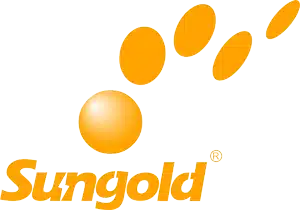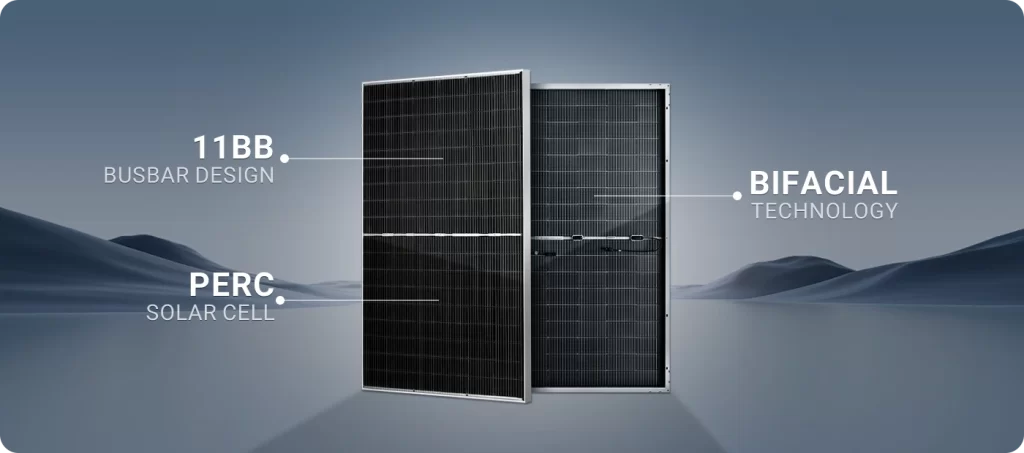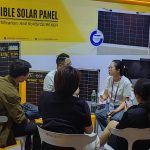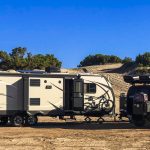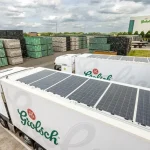As the world shifts toward renewable energy, solar power continues to be a leading solution. Among the latest innovations, bifacial solar panels are gaining attention for their ability to capture light from both sides, offering significant potential. But do they outperform traditional monofacial panels? Let’s explore the benefits, considerations, and the future of bifacial solar technology.
What Are Bifacial Solar Panels?
Bifacial solar panels are designed to absorb sunlight from both the front and rear surfaces. Unlike traditional monofacial panels, which only capture light from the front, bifacial panels make use of sunlight reflected from the ground. This dual-sided functionality increases their efficiency, especially in environments where reflected light is abundant.
Advantages of Bifacial Solar Panels
Bifacial solar panels are rapidly gaining attention for their unique design and ability to harness solar energy more efficiently than traditional monofacial panels. Here’s a detailed breakdown of the main advantages:
Increased Energy Production
One of the primary reasons people are turning to bifacial solar panels is their ability to generate more electricity compared to monofacial panels.
How It Works: Bifacial panels capture sunlight from both the front and the rear of the panel. The rear side of the panel captures reflected sunlight from the ground or surrounding surfaces, which increases the overall amount of energy produced.
Energy Gain: Studies have shown that bifacial panels can produce between 5% and 30% more electricity than their monofacial counterparts. The increase in energy production is most significant in areas with high reflectivity, such as desert landscapes, sandy terrains, or rooftops painted white or light colors. Reflective surfaces like these help bounce sunlight onto the rear side of the panel, effectively doubling the amount of usable sunlight.
Real-World Impact: For example, in environments with a lot of reflective surfaces, such as a sandy desert, the rear-facing side of a bifacial solar panel can capture additional sunlight that would otherwise be wasted, significantly boosting the overall energy yield.
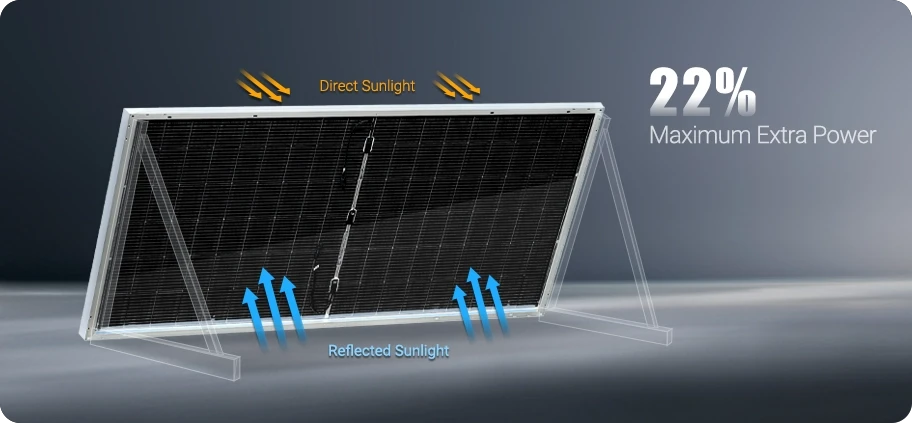
Enhanced Durability
Bifacial panels are designed with durability in mind, often incorporating a dual-glass construction.
Dual-Glass Design: Unlike traditional panels, which often use a single glass layer, bifacial panels feature glass on both sides. This makes them more resistant to environmental wear and tear, such as hail, snow, and wind.
Longer Lifespan: The dual-glass design helps protect the solar cells from environmental stress, which not only extends the panel’s lifespan but also improves its long-term performance. As a result, bifacial panels typically come with longer warranties, often up to 30 years—significantly longer than the standard 10 to 20 years offered by many monofacial panels.
Lower Maintenance Costs: The durability of bifacial panels means that they are less likely to suffer from issues such as cracked glass or damage from extreme weather conditions, leading to fewer maintenance issues and potentially lowering the long-term cost of ownership.
Better Performance in Diffused Light
Bifacial panels have an edge when it comes to generating energy in diffused light conditions.
What Is Diffused Light? Diffused light occurs when sunlight is scattered by clouds, fog, or pollution. On cloudy or overcast days, sunlight reaches the surface in a more diffuse form, meaning it is scattered in different directions and is less direct.
How Bifacial Panels Help: Unlike traditional monofacial panels, which may struggle in such conditions, bifacial solar panels are better equipped to capture this scattered, indirect light. The rear side of the panel can capture sunlight reflected off surfaces like the ground, buildings, or snow. This allows bifacial panels to maintain or even increase their energy production, even when direct sunlight is limited.
Improved Efficiency: In environments where the sun isn’t always shining brightly, such as in temperate climates or areas with frequent cloud cover, bifacial panels can outperform traditional panels and help maintain more consistent energy production throughout the day.
Versatile Installation Options
Another advantage of bifacial solar panels is their installation flexibility, which opens up a range of potential configurations that can maximize energy production.
Vertical Installations: One of the unique installation options for bifacial panels is vertical setups. These configurations allow the panels to capture sunlight during the early morning and late afternoon when the sun is at a lower angle in the sky. This can be particularly useful in areas where space is limited but maximizing energy capture is a priority.
Ground-Mounted Systems: Bifacial panels are particularly effective in ground-mounted installations, where the panels are elevated to allow sunlight to reach both sides of the panel. Ground-mounted systems also make it easier to take advantage of reflective surfaces like snow or light-colored ground.
Adaptable to Various Environments: Bifacial panels are not limited to traditional rooftop applications. They can be adapted to a variety of environments and installations, including agricultural settings (agrovoltaics), carports, or commercial installations where reflective surfaces can enhance their performance. This versatility can be especially important for maximizing solar energy generation in unique or constrained spaces.
Considerations When Choosing Bifacial Solar Panels
While bifacial solar panels offer numerous benefits, there are important factors to consider before deciding if they are the right choice for your project. Here are some key considerations:
- Higher Initial Costs
Bifacial solar panels are typically more expensive than traditional monofacial panels due to their more complex design and dual-glass structure. For users with a limited budget, this price difference may be an important factor to consider. - Installation Complexity
Installing bifacial solar panels requires more precise planning and expertise, often involving additional equipment and more installation time. To fully take advantage of their dual-sided functionality, professional help may be needed. - Ideal Environmental Conditions
Bifacial solar panels perform best in areas with reflective surfaces, such as sandy, snowy, or light-colored ground. Without these reflective surfaces, the additional energy gains may not justify the higher investment.
New Trends in Bifacial Solar Panels
With the continuous advancement of renewable energy technology, bifacial laminated solar panels are becoming more mature. Many portable solar panel manufacturers are now exploring the integration of this bifacial technology into mobile energy products. This trend not only enhances solar panels’ power generation efficiency but also significantly increases their energy output.
Portable bifacial solar panels are becoming an important trend in mobile energy solutions. By incorporating advanced bifacial technology, these products improve efficiency, adaptability, and convenience. As technology advances and market demand grows, more innovative portable solar products are expected to emerge, providing users with more reliable and efficient energy solutions. Bifacial solar panels will offer new possibilities for outdoor adventures or daily use.
Best Bifacial Solar Panel
Sungold SG-DG Series bifacial solar panels combine bifacial technology with a dual-glass design, offering enhanced efficiency and durability for various solar applications. By capturing sunlight from both sides, these panels can generate up to 22% more energy than traditional models, making them ideal for environments with reflective surfaces.
Key Benefits
- Higher Efficiency: Dual-sided energy capture increases output by up to 22%.
- Durability: The dual-glass structure ensures long-lasting performance, with a 30-year lifespan and resistance to harsh weather.
- Flexible Installation: Suitable for various setups, including vertical installations on fences and BIPV applications.
- Weather Resilience: Designed to withstand extreme snow and wind loads, with IP68 protection for durability in all conditions.
Warranty & Certification
- 12-year material warranty and 30-year power guarantee with minimal degradation.
- CE and RoHS certified, ensuring safety and environmental compliance.
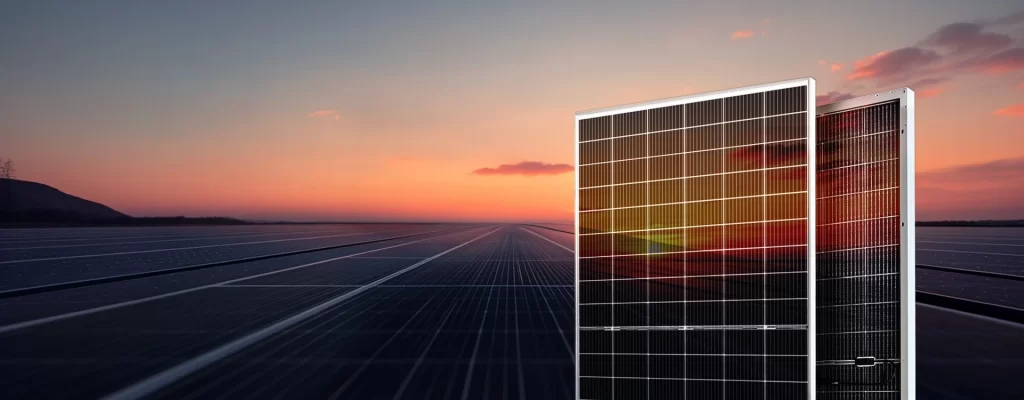
FAQ: Bifacial Solar Panels
1. What are the disadvantages of bifacial solar panels?
Bifacial panels have a higher upfront cost and require more complex installation. They also perform best in environments with reflective surfaces, so their extra efficiency might not always justify the cost.
2. Are bifacial solar panels worth it?
Yes, if you have suitable conditions like reflective surfaces, they can generate up to 22% more energy, making them a good investment despite the higher initial cost.
3. Which is better: bifacial or monocrystalline solar panels?
- Bifacial panels are better in reflective environments for higher energy production.
- Monocrystalline panels are more cost-effective and easier to install for most residential applications.
4. Where can bifacial solar panels be used?
Bifacial panels work well in ground-mounted systems, solar pergola, and vertical installations like fences or BIPV walls, especially in areas with reflective surfaces.

